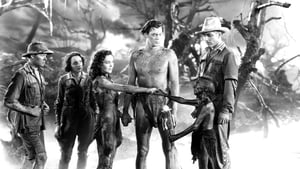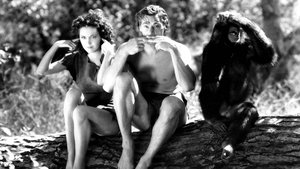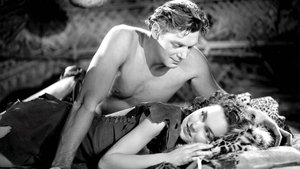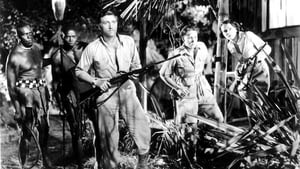Contact: info@alwanfilm.com
Video Sources 0 Views
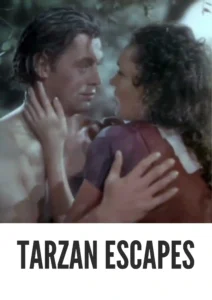
Synopsis
Review: Tarzan Escapes 1936 Colorized – A Classic Adventure Revisited

Introduction
“Tarzan Escapes 1936” is a classic adventure film that has captivated audiences for decades. Directed by Richard Thorpe and John Farrow, this third installment in the Tarzan series stars Johnny Weissmuller and Maureen O’Sullivan, whose on-screen chemistry and riveting performances brought the iconic characters of Tarzan and Jane to life. In this article, we will delve into the impact of the film’s early colorization, discuss its significance in the context of film history, and explore its enduring legacy.
Check The Full Colorized Movies List
Check Our Colorized Movies Trailer Channel
Understanding Tarzan Escapes 1936 Colorized: Director, Cast, and Genre
“Tarzan Escapes 1936” was brought to life by directors Richard Thorpe and John Farrow, who took over after the original director, James C. McKay, departed due to creative differences. Johnny Weissmuller reprised his role as Tarzan, the Lord of the Jungle, while Maureen O’Sullivan returned as Jane. The film also introduced John Buckler as Captain Fry, who serves as the main antagonist.
The Tarzan series, based on the novels by Edgar Rice Burroughs, has been a staple of the adventure genre. “Tarzan Escapes 1936” continued the tradition with its thrilling storyline, exotic settings, and dynamic action sequences, further cementing its place in the annals of classic Hollywood cinema.
Exploring the World of Tarzan Escapes 1936 Colorized: Plot and Characters
“Tarzan Escapes 1936” follows the story of Jane’s cousins, Eric and Rita, who come to Africa to bring Jane back to civilization so she can claim her inheritance. Captain Fry, a devious hunter, sees an opportunity to capture Tarzan and exhibit him as a sideshow attraction. As Tarzan and Jane navigate the dangers posed by Fry and the jungle, their bond is tested, and their love for each other is reaffirmed.
The film’s characters are richly drawn, with Tarzan embodying the noble savage archetype, and Jane representing the bridge between the civilized world and the untamed jungle. The antagonists, led by Captain Fry, add tension and excitement, making “Tarzan Escapes 1936” a compelling adventure.
The Art of Film Colorization
Film colorization involves adding color to black and white films, a process that has sparked considerable debate. Proponents argue that colorization makes classic films more accessible and appealing to modern audiences, while critics contend that it can compromise the original artistic vision and historical integrity.
The technology and techniques for colorization have evolved significantly over the years. Early attempts involved labor-intensive processes, but modern digital technology has streamlined colorization, allowing for more accurate and lifelike results. This technological advancement has rekindled interest in classic films, offering a new way to experience beloved stories.
Early Colored Films: A Brief History
The journey of color in cinema began in the early 20th century, with filmmakers experimenting with various methods to bring vibrant hues to the silver screen. Hand-painted frames, tinting, and toning were among the first techniques used to introduce color into black and white films.
The advent of Technicolor in the 1930s marked a significant milestone, allowing for more vivid and realistic color reproduction. This innovation transformed the cinematic landscape, leading to the creation of visually stunning films that captivated audiences with their rich palettes and immersive worlds.
Tarzan Escapes 1936 and Its Early Colored Version
The decision to release “Tarzan Escapes 1936” in a colorized format reflects a desire to enhance the visual appeal of this classic adventure. While the original black and white version is cherished for its nostalgic charm, the colorized version offers a fresh perspective, highlighting the lush jungle settings and dynamic action sequences.
Colorization brings a new dimension to the film, accentuating the natural beauty of the African landscape and the exotic wildlife that populates Tarzan’s world. It allows viewers to appreciate the film’s artistry in a new light, while also sparking discussions about the balance between preserving the original and embracing modern technology.
The Debate Over Film Colorization
The colorization of classic films like “Tarzan Escapes 1936” remains a contentious issue within the film community. Advocates argue that colorization can attract younger audiences and breathe new life into old films. However, critics worry that altering the original aesthetic undermines the filmmakers’ intent and diminishes the historical authenticity.
This debate highlights the broader tension between tradition and innovation in the film industry. While some view colorization as a necessary evolution to keep classic films relevant, others see it as a departure from the original artistry that defined these works. As technology continues to evolve, this debate is likely to persist, reflecting the diverse perspectives within the cinematic community.
Examining Tarzan Escapes 1936 as an Early Colored Film
Viewing “Tarzan Escapes 1936” in its early colored incarnation offers a unique experience, blending the nostalgia of classic cinema with the visual vibrancy of modern technology. The colorization process brings the film’s jungle settings to life, enhancing the sense of adventure and immersion.
However, the transition from black and white to color is not without its challenges. The nuances of light and shadow, so integral to the original film’s aesthetic, must be carefully preserved to maintain the integrity of the visual storytelling. When done well, colorization can enhance the viewing experience, but it also requires a delicate balance to avoid compromising the film’s original charm.
Influence and Legacy: Tarzan Escapes 1936 Colorized’s Impact on Cinema
“Tarzan Escapes 1936” has left a lasting impact on the adventure genre and the broader cinematic landscape. The film’s portrayal of Tarzan and Jane has become iconic, influencing countless adaptations and reinterpretations over the years. The Tarzan series itself has inspired generations of filmmakers, contributing to the enduring popularity of jungle adventure films.
The success of “Tarzan Escapes 1936” helped solidify Johnny Weissmuller’s status as the definitive Tarzan, a role he would reprise in several more films. Maureen O’Sullivan’s portrayal of Jane also became a benchmark for future adaptations, her character embodying both grace and resilience.
Director’s Cinematic Legacy: Beyond Tarzan Escapes 1936 Colorized
The directors of “Tarzan Escapes 1936,” Richard Thorpe and John Farrow, both made significant contributions to the film industry. Richard Thorpe, known for his prolific career, directed numerous films across various genres, leaving an indelible mark on Hollywood. John Farrow, an accomplished director and screenwriter, also made a substantial impact, with a career spanning several decades.
Their work on “Tarzan Escapes 1936” showcases their ability to craft engaging narratives and dynamic action sequences, contributing to the film’s enduring appeal. Beyond this film, their contributions to cinema reflect a dedication to storytelling and a commitment to pushing the boundaries of the medium.
Themes Explored in Tarzan Escapes 1936 Colorized
“Tarzan Escapes 1936” explores themes of civilization versus nature, freedom versus captivity, and the enduring power of love. The film contrasts the untamed beauty of the jungle with the encroaching influence of civilization, highlighting the tension between these two worlds.
Tarzan’s struggle to protect his home and loved ones from external threats reflects broader themes of resistance and survival. Jane’s journey, torn between her past life and her love for Tarzan, adds emotional depth to the narrative, emphasizing themes of loyalty and sacrifice.
Reception and Controversy Surrounding Tarzan Escapes 1936 Colorized
Upon its release, “Tarzan Escapes 1936” received a mixed reception, with some critics praising its action sequences and performances, while others critiqued its pacing and plot. The film’s colorized version has reignited discussions about the merits and drawbacks of altering classic films.
The controversy surrounding the colorization of “Tarzan Escapes 1936” mirrors broader debates in the film community about preservation and modernization. While some appreciate the enhanced visual appeal, others argue that the original black and white version should be preserved as a testament to the filmmakers’ vision.
Where to Watch Tarzan Escapes 1936 Colorized Online
For those eager to experience the adventures of Tarzan and Jane, “Tarzan Escapes 1936” is available on various streaming platforms. Both the original black and white version and the colorized rendition can be found on services such as Amazon Prime Video, Hulu, and classic film streaming sites.
These platforms provide easy access to this timeless classic, allowing new audiences to discover the magic of Tarzan and Jane’s adventures, while also offering long-time fans a chance to revisit a beloved film.
FAQs About Tarzan Escapes 1936 Colorized
Q: Is “Tarzan Escapes 1936” based on a book?
A: Yes, “Tarzan Escapes 1936” is based on the character created by Edgar Rice Burroughs. The film takes inspiration from Burroughs’ Tarzan series, though it features an original story.
Q: Who played Tarzan and Jane in the film?
A: Johnny Weissmuller played Tarzan, and Maureen O’Sullivan portrayed Jane. Their performances are widely regarded as definitive portrayals of the characters.
Q: What is the significance of the film’s title?
A: The title “Tarzan Escapes 1936” refers to the plot’s central conflict, where Tarzan must escape from captivity and thwart the schemes of the antagonists to protect his jungle home and loved ones.
Q: What are the main themes of “Tarzan Escapes 1936”?
A: The film explores themes of civilization versus nature, freedom versus captivity, and the enduring power of love and loyalty.
Conclusion
In conclusion, “Tarzan Escapes 1936” stands as a testament to the enduring appeal of classic adventure cinema. The early colorized version offers a fresh perspective, enhancing the film’s visual appeal while sparking discussions about the balance between preserving the original and embracing modern technology. Whether viewed in its original black and white format or its vibrant colored rendition, “Tarzan Escapes 1936” remains a captivating journey into the heart of the jungle and the timeless struggle between civilization and nature.
As we continue to explore the evolving landscape of cinema, let us honor the legacy of films like “Tarzan Escapes 1936” and the visionary artists who brought them to life. Their work reminds us of the power of storytelling to transcend time and space, connecting us to the past while inspiring future generations.
